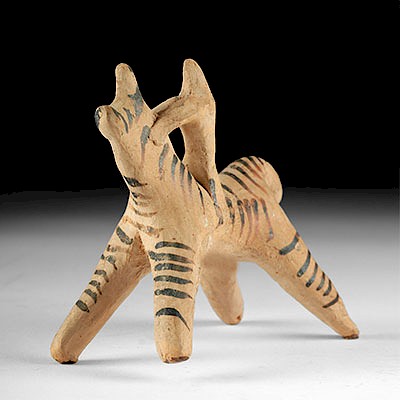Egyptian Polychrome Gesso Sarcophagus Foot Covering
Lot 3c
About Seller
Artemis Fine Arts
686 S Taylor Ave, Ste 106
Louisville, CO 80027
United States
Selling antiquities, ancient and ethnographic art online since 1993, Artemis Gallery specializes in Classical Antiquities (Egyptian, Greek, Roman, Near Eastern), Asian, Pre-Columbian, African / Tribal / Oceanographic art. Our extensive inventory includes pottery, stone, metal, wood, glass and textil...Read more
Estimate:
$6,000 - $9,000
Absentee vs Live bid
Two ways to bid:
- Leave a max absentee bid and the platform will bid on your behalf up to your maximum bid during the live auction.
- Bid live during the auction and your bids will be submitted real-time to the auctioneer.
Bid Increments
| Price | Bid Increment |
|---|---|
| $0 | $25 |
| $300 | $50 |
| $1,000 | $100 |
| $2,000 | $250 |
| $5,000 | $500 |
| $10,000 | $1,000 |
| $20,000 | $2,500 |
| $50,000 | $5,000 |
| $100,000 | $10,000 |
| $200,000 | $20,000 |
About Auction
By Artemis Fine Arts
Oct 25, 2018
Set Reminder
2018-10-25 11:00:00
2018-10-25 11:00:00
America/New_York
Bidsquare
Bidsquare : Antiquities from Egypt, Greece, Italy, Asia
https://www.bidsquare.com/auctions/artemis-gallery/antiquities-from-egypt-greece-italy-asia-3538
Featuring Egyptian, Greek, Roman, Etruscan, Near Eastern, plus Asian art from Central and Far East. If you love the classics, this is the sale for you. Artemis Fine Arts info@artemisfinearts.com
Featuring Egyptian, Greek, Roman, Etruscan, Near Eastern, plus Asian art from Central and Far East. If you love the classics, this is the sale for you. Artemis Fine Arts info@artemisfinearts.com
- Lot Description
Ancient Egypt, Late Period, ca. 664 to 332 BCE. A brightly painted gesso over cloth model of feet, made to be used as the covering for the feet of an anthropoid sarcophagus containing a mummified individual. The feet are painted with long toes with round, white toenails. They are depicted wearing strapped sandals, with the thin straps painted between the toes and around the bridge of the foot. The toes are painted onto a dark base, with alternating creamy white, red, and dark blue stripes around its edge; a similar pattern is painted around the ankle, which is where the object terminates. Red lines, dots, and hook-shapes are painted on the feet, perhaps indicating some decoration that was worn in life. On the underside, the soles of the feet are painted brightly, with checkerboard patterns on the toes and heels and long lines on the arches. A stylized lotus flower is between the feet. Size: 9.5" L x 6.7" W x 5.9" H (24.1 cm x 17 cm x 15 cm)
Egyptians cultivated white lotuses in the marshy land around the Nile, and it was believed that the flower gave them power and strength, relating to the use of a stylized lotus as a capital motif at the top of their columns. Lotuses were used as funerary adornments - for example, remains of the flower have been found in the tomb of Ramesses II - and as temple offerings and garlands worn by women during rituals. The hieroglyph for the number 1000 is represented by the symbol.
Provenance: purportedly ex-Sotheby's, 1980s; ex-private New York, USA collection; ex-Explore Ancient; ex-Relics of the Nile, Lexington, Kentucky, USA
All items legal to buy/sell under U.S. Statute covering cultural patrimony Code 2600, CHAPTER 14, and are guaranteed to be as described or your money back.
A Certificate of Authenticity will accompany all winning bids.
We ship worldwide and handle all shipping in-house for your convenience.
#139163Feet are a fragment of a larger item. Nice preservation of pigment, with some flaking, notably at edges. Colors remain bright and details are clear.Condition
- Shipping Info
-
All shipping is handled in-house for your convenience. Your invoice from Artemis Gallery will include shipping calculation instructions. If in doubt, please inquire BEFORE bidding for estimated shipping costs for individual items.
-
- Buyer's Premium



 EUR
EUR CAD
CAD AUD
AUD GBP
GBP MXN
MXN HKD
HKD CNY
CNY MYR
MYR SEK
SEK SGD
SGD CHF
CHF THB
THB















